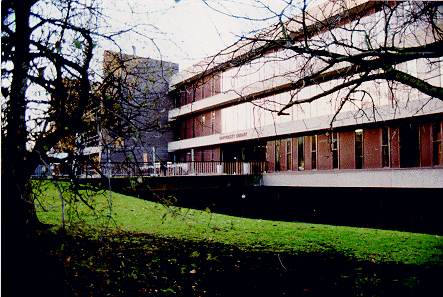Down Your Way: Durham
Spread across four sites within the small historic city of Durham, the University Library caters for a diverse range of staff and student requirements, as well as acting in an important archival role for the surrounding area.
The University of Durham [1] is the third oldest university in England, with some 8,300 undergraduate and 1,900 postgraduate students. The library plays a key part in supporting these students - and the large body of research staff - both through the provision of traditional services and through a joint programme with the IT Service to provide training in general information skills.
The main library building dates to the 1960s, when it was built as a science library to service the university's science site which adjoins it. Extended in 1983, the building became the main library, and it is now once more sufficiently stretched as to warrant a further extension, due for completion in 1997. With the construction of this latest extension, Marilyn Hird, who is responsible for the library's Web pages, hopes that the library will be able to offer 24-hour access to some of the building's facilities.
 The building contains a single group of networked PCs, managed by the IT Service and offering a similar interface and range of applications as the other computer classrooms scattered around the university. Despite my visit being during the vacation, all of the machines were occupied by industrious-looking students. With the completion of the extension, it is hoped that networked PC provision within the library may be extended.
The building contains a single group of networked PCs, managed by the IT Service and offering a similar interface and range of applications as the other computer classrooms scattered around the university. Despite my visit being during the vacation, all of the machines were occupied by industrious-looking students. With the completion of the extension, it is hoped that networked PC provision within the library may be extended.
The most used service in the building is, perhaps not surprisingly, access to the newly upgraded On-line Public Access Catalogue via the text-only terminals available in small groups throughout all floors of the library. The new Innopac system was installed in September of 1996 and is proving popular with both library staff and users. According to Ros Pan, who maintains the system, there are now some 46,000 OPAC searches per week. Of these, only around 1,000 are via the promising WebPAC Web-based interface [2] , but this number may well rise as the proportion of Web-enabled machines physically within the library rises, and as staff and students elsewhere in the university become more aware of this new facility.
The library's current Web service [3] has been in existence for some eighteen months and in that time has replaced both an earlier Gopher service and more traditional paper notices as the main method by which the library provides access to information. Throughout the pages, simplicity and clarity are paramount, with very few images to be seen, and information laid out on a number of relatively sparse pages in such a way as to draw the user down towards the facts they require, rather than bombarding them with everything at once.
Extensive use is made of existing services, with frequent links to national initiatives such as NISS [4] and, as well as to the commercial search engines, useful connections to other university libraries such as York's Subject Tree [5] , and the pages of other Durham departments.
Moving up the hill to another library site, set halfway between the imposing structures of cathedral and castle, I entered the domain of Richard Higgins and the Archives and Special Collections. Here, an eLib- related initiative is using JISC funding to aid the retrospective conversion of archival lists in order to make them available across the Web. This truly daunting task encompasses well over one hundred separate collections in a wide range of document types and subjects, ranging from hand-written documents spanning centuries (and, in some cases, still being updated today) to printouts of early word-processed lists. Many of the documents are local, including early university records, collections of papers of prominent local families, solicitors' papers and literary archives, and the muniments of Durham Cathedral's Dean and Chapter . The collection also includes material from further afield such as the papers of an Egyptian Khedive at the turn of the century and the important Sudan Archive.
In the first instance, Higgins aims to produce a basic ASCII text file for each list, but his long term aim is more ambitious, as he is beginning to explore converting all of the files using the Encoded Archival Description (EAD) Document Type Definition. With this conversion work completed, it will become possible to utilise the full power of SGML in searching through this vast archive, hopefully enabling both display of the holdings via the Web and more flexible searching within and between holdings than is offered by most document-oriented database systems. With just over two years left to run, it will be interesting to see how flexible a resource can be created in this way. Certainly many frustrated users of traditional paper and fiche archives will await the results of this project with interest.
References
[1] University of Durham Web site,
http://www.dur.ac.uk/
[2] WebPAC Web-based interface,
http://gutenberg.dur.ac.uk/
[3] Durham Library Current Awareness Service,
http://www.dur.ac.uk/Library/
[4] NISS Web Site,
http://www.niss.ac.uk/
[5] Subject Tree at York,
http://www.york.ac.uk/services/library/subjects/subjlist.htm
Author Details
Paul Miller is a Graphics & GIS Adviser at the University of Newcastle.
Email: A.P.Miller@ncl.ac.uk
